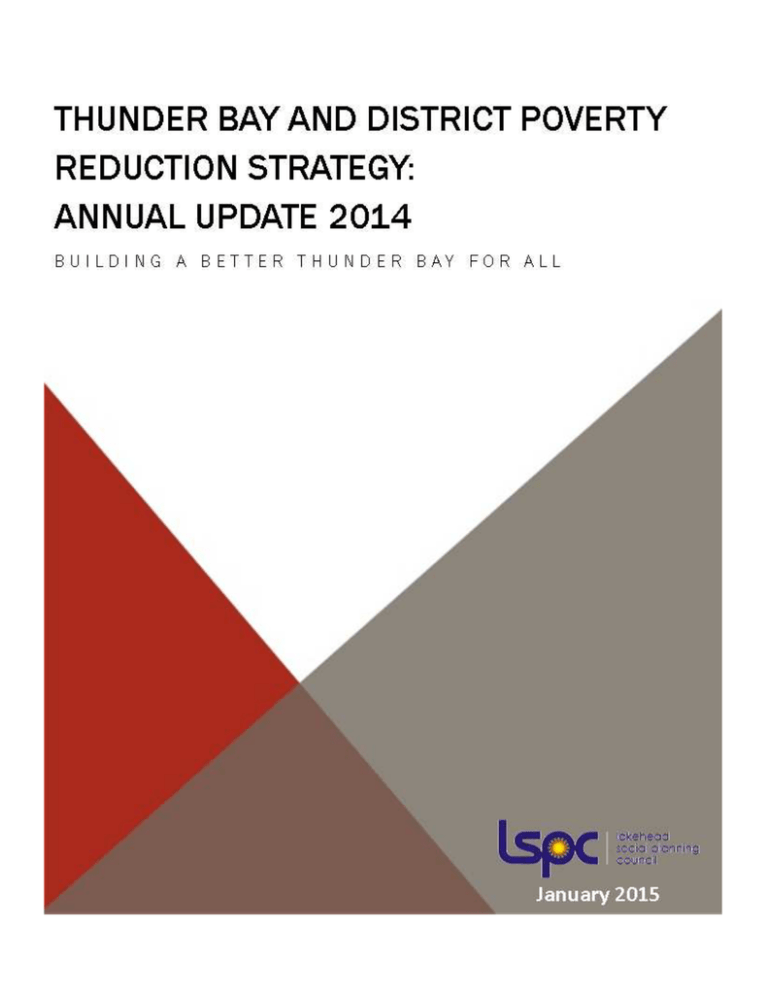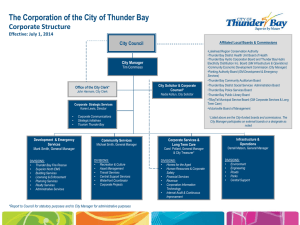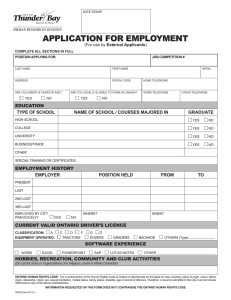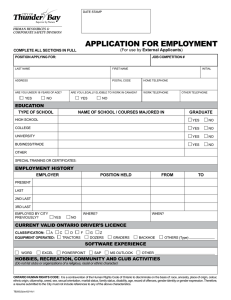Thunder Bay and District Poverty Reduction Strategy Annual Report
advertisement

Thunder Bay and District Poverty Reduction Strategy: Annual Report Saku Pinta, PhD and Mike Jones, MSW The Thunder Bay and District Poverty Reduction Strategy is pleased to present its first Annual Report. The Report draws on data drawn from a variety of sources including original data generated from the Lakehead Social Planning Council’s Volunteer Income Tax clinic. The objective is to identify broader social trends, provide data that can be compiled on an annual basis in order to track progress in the Strategy, as well as to provide information that will help to inform evidence-based policy making. Section 1, Defining Poverty, provides the standard statistical measure of poverty used in this report as the Low Income Measure (After-Tax) income threshold. This information is given visual representation over a period of more than 10 years, and correlated with the unemployment rate .................................................................. Page 3 Section 2, the 2013 Income Tax Data Sample Analysis, uses a representative sample of non-identifying data collected from the Volunteer Income Tax Clinic to provide a snapshot of the low income population in Thunder Bay. The data was analyzed using Statistical Package for the Social Sciences (SPSS) software to determine statistically significant correlations in a number of areas including demographics, income, and housing................................................................................................................... Page 4 Section 3, the Wage Calculation Comparison, contextualizes the Low Income Measure by representing a number of different income sources as before-tax annual and hourly wages. Importantly, the minimum wage is shown to be insufficient to meet the Low Income Measure threshold ..................................................................... Page 15 Section 4, the Canadian Centre for Policy Alternatives Living Wage Calculation, uses a standardized methodology to provide a living wage calculation specific to Thunder Bay......................................................................................................... Page 16 Section 5, Comparable Cities to Thunder Bay, provides a peer-group of Canadian cities and statistical information that can be tracked for comparative purposes. ............................................................................................................. Page 16 Section 6, Housing, shows the correlation between Thunder Bay vacancy rates and social housing waitlists, and the related rise in emergency shelter occupancy .... Page 20 Section 7, Conclusions and Recommendations, argues that while measures of relative poverty are trending downward, the position of the poorest and most marginalized residents of Thunder Bay are declining dramatically. Three recommendations are proposed that can help to make a difference in the lives of low income individuals ................................................................................................ Page 21 1. Thunder Bay and District Poverty Reduction Strategy: Annual Report Saku Pinta, PhD and Mike Jones, MSW The Thunder Bay and District Poverty Reduction Strategy is pleased to present its first Annual Report. The Report draws on data drawn from a variety of sources including original data generated from the Lakehead Social Planning Council’s Volunteer Income Tax clinic. The objective is to identify broader social trends, provide data that can be compiled on an annual basis in order to track progress in the Strategy, as well as to provide information that will help to inform evidence-based policy making. Section 1, Defining Poverty, provides the standard statistical measure of poverty used in this report as the Low Income Measure (After-Tax) income threshold. This information is given visual representation over a period of more than 10 years, and correlated with the unemployment rate .................................................................. Page 3 Section 2, the 2013 Income Tax Data Sample Analysis, uses a representative sample of non-identifying data collected from the Volunteer Income Tax Clinic to provide a snapshot of the low income population in Thunder Bay. The data was analyzed using Statistical Package for the Social Sciences (SPSS) software to determine statistically significant correlations in a number of areas including demographics, income, and housing................................................................................................................... Page 4 Section 3, the Wage Calculation Comparison, contextualizes the Low Income Measure by representing a number of different income sources as before-tax annual and hourly wages. Importantly, the minimum wage is shown to be insufficient to meet the Low Income Measure threshold ..................................................................... Page 15 Section 4, the Canadian Centre for Policy Alternatives Living Wage Calculation, uses a standardized methodology to provide a living wage calculation specific to Thunder Bay......................................................................................................... Page 16 Section 5, Comparable Cities to Thunder Bay, provides a peer-group of Canadian cities and statistical information that can be tracked for comparative purposes .............................................................................................................. Page 16 Section 6, Housing, shows the correlation between Thunder Bay vacancy rates and social housing waitlists, and the related rise in emergency shelter occupancy .... Page 20 Section 7, Conclusions and Recommendations, argues that while measures of relative poverty are trending downward, the position of the poorest and most marginalized residents of Thunder Bay are declining dramatically. Three recommendations are proposed that can help to make a difference in the lives of low income individuals ................................................................................................ Page 21 2 Defining Poverty While there is no officially recognized poverty line calculation in Canada, the Low Income Measure (LIM) is one the most frequently used metrics used to determine how many people in a community live in poverty. The LIM is calculated as 50% of the median income, adjusted for family size. The LIM is approximately $21,000 for an individual (based on the 2011 LIM After-Tax calculation, adjusted for inflation). Based on this calculation, approximately 15,100 thousand people in Thunder Bay live below the LIM. Aside from the LIM, it is useful to draw a distinction between “relative” and “absolute” poverty. Relative poverty is the lack of the minimum amount of income required in order to maintain the average standard of living in a given society. Absolute poverty, on the other hand, is the lack of one or more basic needs over a period long enough to endanger life or to cause harm. This distinction is important in the context of this report as the data collected shows a very gradual decrease in social indicators of relative poverty (for example, the LIM and unemployment rate) and a dramatic rise in social indicators of absolute poverty (for example, increases in emergency shelter usage). The graphs below show the gradual downward trend of the percentage of people in low income in Thunder Bay and this trend in relation to the unemployment rate. Percentage of People in Low Income Measure After-Tax in Thunder Bay 14.5 14 Percentage 13.5 13 12.5 12 11.5 2000 2001 2002 2003 2004 2005 2006 Year 3 2007 2008 2009 2010 2011 2012 Percentage of People in Low Income-After Tax in Thunder Bay 14.5 9 8 14 Percentage 13.5 6 5 13 4 12.5 3 2 Percentage in LI-AT 12 Unemployment Rate 1 Linear (Percentage in LI-AT) Linear (Unemployment Rate) 11.5 2000 2001 2002 2003 2004 2005 2006 2007 2008 0 2009 2010 2011 2012 Year 2. 2013 Income Tax Data Sample Analysis For more than ten years the Lakehead Social Planning Council's Community Volunteer Income Tax Program (CVITP) has been completing tax returns for low income members of the Thunder Bay community. As the program has grown, so has its impact. While the program has a clear, positive financial impact on members of the community, it has also opened other possibilities for data collection and analysis. When the Canadian Government made the decision to rescind the long-form census and begin use of a voluntary National Household Survey, the ramifications for researchers were and continue to be damaging. Low income individuals were already one of the most underrepresented groups and the changes to census data only reinforce this reality. 4 Unemployment Rate 7 In 2013, the CVITP collected and completed over 4000 tax returns for low income individuals in the Thunder Bay community and surrounding areas. Low income as defined by the tax clinic is a single individual making $20,000 or less or a couple making a combined $30,000 or less (special circumstances notwithstanding). The data contained within the over 4000 tax returns contributes to a significant annual sample of low income members of Thunder Bay that can be used to introduce more evidence-based policies that benefit those who need it most. The data made available by the CVITP will be collected annually and will help the LSPC's social planners and researchers identify, assess and contextualize trends year-over-year. Of the 4000+ tax returns of low income members of the Thunder Bay community and district that have been completed by the CVITP, we have selected a random sample of 1204. The 1204 tax returns will provide a more than adequate sample for assessing, analyzing and extrapolating data to the low income community in Thunder Bay and district. Although the CVITP does not represent a true “random sampling,” it is nonetheless a representative sample of the low income population in Thunder Bay. This is demonstrated by the maps below. The map of the left represents CVITP users and their locations by postal code in the Thunder Bay Census Metropolitan Area. The map on the right is from Statistics Canada and shows the distribution of people living below the Low Income Measure by census tract. The two maps are nearly identical in terms of the distribution of low income individuals. 5 2.1 Demographics Status vs. Non-status Status Canadian Indian Frequency Valid Percent Valid Percent Cumulative Percent Non-Status 537 44.6 44.6 44.6 Status 667 55.4 55.4 100.0 Total 1204 100.0 100.0 The sample revealed that the majority (55.4%) of the individuals using the tax clinic are Status (Aboriginal) Canadians. Birth Dates In graphing every birth-date within the 1204 person sample, there is a distinct negative skew of the data towards a younger population. 6 Age Ranges Age Ranges Frequency Percent Valid Percent Cumulative Percent Valid 1920-1940 44 3.7 3.7 3.7 1941-1960 275 22.8 22.8 26.5 1961-1980 447 37.1 37.1 63.6 1981-2000 438 36.4 36.4 100.0 1204 100.0 100.0 Total The sample revealed that 73.5% of the individuals who returned their taxes were born after 1960 (under 55 years old). The largest category of individuals using the tax clinic was those born between 1961 and 1980 (ages 35-55) with 37% of the sample, while the lowest was individuals born between 1920 and 1940 at 3.7%. 2.2 Income Pension Income Pension Income Amount Valid 183 N Missing Mean Median Std. Deviation 0 10567.1768 9776.0700 6493.29728 The median income amongst individuals receiving pension income (including Canada Pension Plan and Survivor’s Benefit) was $9,776.07, with 68% of individuals receiving between $3,283 and $16,269. 7 Employment Income Employment Income Amount Valid 1204 N Missing Mean 0 1991.10 Median .00 Std. Deviation 5653.838 Minimum 0 Maximum 35720 In assessing the entire sample, 21.9% of individuals received some form of employment income. The mean of all 1204 individuals was $1991.10 while the median was 0, indicating the majority of individuals claimed no employment income. Employment Income Employment Income Amount Valid 264 N Missing 0 Mean 9080.61 Median 5500.32 Std. Deviation 9032.978 Minimum 39 Maximum 35720 In assessing only the individuals who claimed employment income on their tax return, there was a strong positive skew towards those receiving under $5000 in employment income. The median employment income amount claimed was $5,500.32, while the minimum claimed was $39 and the maximum $35,720. 8 Identifying whether status or non-status plays a role in employment income amount Descriptives Employment Income Amount N Mean Std. Deviation Std. Error 95% Confidence Interval for Mean Lower Bound Minimum Maximum Upper Bound Non-Status 536 2524.09 6398.718 276.383 1981.16 3067.01 0 33767 Status 668 1563.43 4939.772 191.125 1188.15 1938.71 0 35720 Total 1204 1991.10 5653.838 162.941 1671.42 2310.78 0 35720 ANOVA Employment Income Amount Sum of Squares Between Groups df Mean Square 274442885.475 1 274442885.475 Within Groups 38180519175.031 1202 31764159.047 Total 38454962060.506 1203 F Sig. 8.640 .003 There was a statistically significant difference between groups as determined by a one-way ANOVA (F(1,1202) = 8.64, p = .003). Non-Status individuals claimed more employment income than status individuals. Identifying whether status or non-status plays a role in social assistance amount received Descriptives Social Assistance Amount N Mean Std. Deviation Std. Error 95% Confidence Interval for Mean Lower Bound Minimum Maximum Upper Bound Non-Status 536 6799.5349 6192.47928 267.47437 6274.1061 7324.9636 .00 23284.00 Status 668 6938.1468 6111.54296 236.46270 6473.8460 7402.4477 .00 25613.00 Total 1204 6876.4392 6145.52937 177.11121 6528.9580 7223.9204 .00 25613.00 ANOVA Social Assistance Amount Sum of Squares Between Groups df Mean Square 5713685.951 1 5713685.951 Within Groups 45428626362.139 1202 37794198.305 Total 45434340048.090 1203 9 F Sig. .151 .697 There was no statistically significant difference between the amount of social assistance claimed by status and non-status individuals as determined by a one-way ANOVA (F(1,1202) = .151, p = .697). Identifying whether status or non-status plays a role in pension amount received Descriptives Pension Income Amount N Mean Std. Deviation Std. Error 95% Confidence Interval for Mean Lower Bound Minimum Maximum Upper Bound Non-Status 536 2510.8824 5673.94274 245.07700 2029.4512 2992.3136 .00 35563.29 Status 668 880.1802 3236.79563 125.23538 634.2771 1126.0832 .00 25643.94 Total 1204 1606.1407 4558.88248 131.38481 1348.3718 1863.9095 .00 35563.29 ANOVA Pension Income Amount Sum of Squares Between Groups df Mean Square F 39.259 790795329.839 1 790795329.839 Within Groups 24211646268.453 1202 20142800.556 Total 25002441598.293 1203 Sig. .000 There was a statistically significant difference between the amount of pension income claimed as determined by one-way ANOVA (F(1,1202) = 39.259, p = .000). Non-status individuals claimed more than status individuals. Identifying whether status or non-status plays a role in amount of tax returned Descriptives Amount of Return N Mean Std. Deviation Std. Error 95% Confidence Interval for Mean Lower Bound Minimum Maximum Upper Bound Non-Status 536 159.99 537.256 23.206 114.40 205.57 -1369 5778 Status 668 82.31 351.961 13.618 55.57 109.04 -388 3673 1204 116.89 445.579 12.841 91.69 142.08 -1369 5778 Total ANOVA Amount of Return Sum of Squares Between Groups df Mean Square 1794503.735 1 1794503.735 Within Groups 237050250.088 1202 197213.186 Total 238844753.823 1203 10 F 9.099 Sig. .003 There was a statistically significant difference between status and non-status individuals in the amount of income tax returned as determined by one-way ANOVA (F(1,1202) = 9.099, p = .003). Non-status individuals had more money returned than status individuals. Identifying the relationship between gender and WSIB claim amounts Descriptives WSIB Amount N Mean Std. Deviation Std. Error 95% Confidence Interval for Mean Lower Bound Minimum Maximum Upper Bound Female 769 47.70 640.015 23.080 2.39 93.00 0 10849 Male 435 207.87 1642.764 78.765 53.06 362.68 0 20791 Total 1204 105.57 1114.008 32.105 42.58 168.55 0 20791 ANOVA WSIB Amount Sum of Squares Between Groups df Mean Square 7127954.296 1 7127954.296 Within Groups 1485811379.249 1202 1236115.956 Total 1492939333.545 1203 F Sig. 5.766 .016 Males receive more WSIB and is statistically significant p=.016 2.3 Housing Identifying whether status or non-status plays a role in amount spent on housing Descriptives Housing Amount N Mean Std. Deviation Std. Error 95% Confidence Interval for Mean Lower Bound Minimum Maximum Upper Bound Non-Status 536 3733.38 3189.627 137.771 3462.75 4004.02 0 15600 Status 668 3130.68 3350.918 129.651 2876.11 3385.26 0 19200 Total 1204 3398.99 3292.410 94.886 11 3212.83 3585.15 0 19200 ANOVA Housing Amount Sum of Squares Between Groups df Mean Square F 10.040 108023877.994 1 108023877.994 Within Groups 12932451148.989 1202 10759110.773 Total 13040475026.983 1203 Sig. .002 There was a statistically significant difference the amount spent on housing by status and non-status individuals as determined by one-way ANOVA (F(1,1202) = 10.04, p = .002). Non-status individuals spent more on housing than status individuals. Gender and Amount Spent on Housing Descriptives Housing Amount N Mean Std. Deviation Std. Error 95% Confidence Interval for Mean Lower Bound Minimum Maximum Upper Bound Female 769 3561.75 3380.930 121.919 3322.41 3801.08 0 19200 Male 435 3111.28 3112.827 149.249 2817.94 3404.62 0 14400 Total 1204 3398.99 3292.410 94.886 3212.83 3585.15 0 19200 ANOVA Housing Amount Sum of Squares Between Groups df Mean Square F 5.219 56380011.134 1 56380011.134 Within Groups 12984095015.849 1202 10802075.720 Total 13040475026.983 1203 Sig. .023 Females pay more for housing, p=.023 2.4 Other results • No statistical significance between employment income amount and marital status • Widows receive less than other groups (single, p=.000; common law, p=.000; married, p=0.001; divorced, p=.009; separated, p=.000) in social assistance. No other significance between groups (no groups earn more or less than other groups). 12 • No statistical significance between marital status and bus passes expense • No statistical significance between marital status and amount spent on housing • No statistical significance between marital status and tax amount returned • Widows donate more than any other group by a large margin • Singles receive less WSIB than married people (p=.004); all other groups showed no significant differences. • Number of dependents had no statistical effect on amount claimed for transportation expenditures • Number of dependents had no statistical effect on amount claimed for medical expenditures • Individuals with five dependants received statistically significantly more in social assistance compared to individuals with 2 (p=.006), 1 (p=.011) and 0 (p=.004) dependents • Individuals with zero dependents received statistically significantly more in pension assistance compared to individuals with 2 (p=.014) and 1 (p=.001) dependent • Number of dependants had no statistical effect on employment income earned • Those born between 1940-60 claimed statistically significantly more in medical expenses (all p=.000) • Gender and employment income were not significant • Gender and pension income were not significant • Gender and social assistance were not significant 13 2.5 Volunteer Income Tax Program Users from outside of the Thunder Bay Census Metropolitan Area The map below shows the distribution Volunteer Income Tax Program users from outside of the Thunder Bay Census Metropolitan Area. It is unlikely that these individuals travelled to Thunder Bay solely for the purpose of filing their tax returns. As such, the map demonstrates that the city acts as an important hub for services for individuals throughout the District and region. 14 3. Wage Calculation Comparison As previously mentioned, although Canada has no officially defined measure of poverty, most countries around the world are using the Low Income Measure (LIM) as a starting point. This is beneficial for international comparisons. The 2014 Low Income Measure for Canada adjusted for inflation is $24,992 before-tax. Displaying a low income measure can sometimes make it difficult to conceptualize what it means for those working or utilizing government programs. What does $24,992 look like as an hourly wage assuming a 35 hour workweek (the standard measure for a fulltime work week) for 52 weeks a year, with only statutory holidays off? What are people on Ontario Works receiving as an hourly wage? The following chart uses annual figures to be paid out through specific programs or measures and parses them down into an hourly wage. Assessing the annual incomes of various programs and measures as an hourly rate reveals a harsh reality. Ontario Works recipients are only receiving the equivalent of $4.50/hr; in an eight hour workday they’d make $36 before-tax. To display the most accurate, comparative figures of annual income and wages, it is important to use before-tax measures of income as wages are almost exclusively discussed in terms of the before-tax amount. An individual who is working full-time for minimum wage in Ontario will make $11.00/hr, more than $2 below the $13.02/hr necessary to reach the unofficial poverty line. This has a number of implications for the working class. Income Source Annual Hourly 2014 CPI Adjusted Low Income Measure $24,992 $13.02 Minimum Wage $20,020 $11.00 Ontario Works $7,872 $4.32 Ontario Disability Support Program $13,032 $7.16 Employment Insurance Maximum (45 week maximum) $23,130 $14.68 Canadian Pension Plan (CPP) Maximum $12,460 $6.84 $7,960,000 $4,373.62 Average Canadian CEO (top 100) 15 4. Canadian Centre for Policy Alternatives Living Wage Calculation Currently, the minimum wage in Ontario is $11.00 before-tax per hour. This amount translates to an annual income of $20,020 assuming the individual has worked 35 hours a week and only received statutory vacation time. Working full-time and earning minimum wage is not enough to meet the Low Income Measure. The living wage is one approach that many communities across Canada are advocating as a way to ensure that earned income is sufficient to meet basic needs. A living wage calculation differs from the minimum wage. The minimum wage is the legal minimum that an employer must pay to employees, as determined by the province. A living wage is defined as the hourly rate that a worker in a family would need to earn to meet the basics of quality of life based on the cost of living specific to a community. The methodology adopted for the Thunder Bay living wage calculation is from the Canadian Centre for Policy Alternatives model. According to the Canadian Centre for Policy Alternatives template, the requirement for a living wage in Thunder Bay is $30,030 annually and $16.50/hr before-tax. A living wage intends to assess the wage necessary for living a fulfilling and healthy lifestyle. While the living wage is debatable in regards to what should be included in the calculations, there is broad consensus that a living wage should include the costs of: a home phone, internet usage, healthy foods, utilities, clothing, transportation, health coverage, tuition and daycare, two weeks of pay in savings and recreation. Presently, the hourly gap between the minimum wage and a living wage in Thunder Bay is $5.50/hr. This is an alarming statistic as each year the minimum wage stays stagnant, the gap between the working poor and a healthy, prosperous lifestyle will grow. 5. Comparable Cities to Thunder Bay To contextualize the impact of poverty on a specific community, Thunder Bay was compared to a number of other similar cities to form a comparison. The cities were selected based upon: isolation, demographics, labour market conditions, population, health region peer groups and transit peer groups. As a result of the size of Canada, comparable cities were identified in regards to their geographic location. The comparable cities are: Northern Ontario Sault Ste. Marie Sudbury Western Canada Kamloops Prince George Lethbridge Southern Ontario Peterborough Kingston Brantford Eastern Canada Saint John St. John’s Moncton 16 Key benchmarks of poverty were identified in the research process and used to compare Thunder Bay to other cities. The results are as follows: Health & Social Inclusion 1. Access to a Regular Medical Doctor by Health Region StatsCan Table 105-0501 Health Indicators - Regular Medical Doctor (2013) Zone 1 (Moncton Area), NB Peterborough County-City, ON Kingston, Frontenac and Lennox and Addington, ON Brant County, ON Zone 2 (Saint John area), NB Eastern Regional Integrated Health Authority, NL District of Algoma, ON South Zone, AB Interior Health Authority, BC Thunder Bay District, ON Northern Health Authority, BC Sudbury and District, ON Ontario Canada City Moncton Peterborough Kingston Brantford Saint John St. John’s Sault Ste. Marie Lethbridge Kamloops Thunder Bay Prince George Sudbury Percentage 94.3 94.1 92.9 92.8 91.8 90.5 90.1 88.6 85.9 82.3 82.3 81.6 91.2 84.5 Thunder Bay ranks low in regards to the number of individuals over 12 years old who have access to a regular medical doctor and is far below the provincial average. 2. Heavy Drinking by Health Region StatsCan Table 105-0501 Health Indicators - Heavy Drinking (2013) Thunder Bay District, ON Eastern Regional Integrated Health Authority, NL Zone 1 (Moncton Area), NB District of Algoma, ON Peterborough County-City, ON Sudbury And District, ON Interior Health Authority, BC Northern Health Authority, BC Kingston, Frontenac and Lennox and Addington, ON South Zone, AB Brant County, ON Zone 2 (Saint John area), NB Ontario Canada 17 City Thunder Bay St. John’s Moncton Sault Ste. Marie Peterborough Sudbury Kamloops Prince George Kingston Lethbridge Brantford Saint John Percentage 26.6 26.1 26.0 23.8 22.0 21.4 21.1 20.3 19.6 19.2 16.1 16.1 17.1 18.9 Thunder Bay ranks the highest in heavy drinking, which refers to males who reported having 5 or more drinks, or women who reported having 4 or more drinks, on one occasion, at least once a month in the past year. Thunder Bay is well above the provincial average for heavy drinking. 3. Sense of Belonging to Community StatsCan Table 105-0501 Health Indicators - Sense of Belonging to Community (strong/very strong) (2013) Zone 2 (Saint John area), NB South Zone, AB Eastern Regional Integrated Health Authority, NL Thunder Bay District, ON Northern Health Authority, BC Interior Health Authority, BC Kingston, Frontenac and Lennox and Addington, ON Zone 1 (Moncton Area), NB Sudbury And District, ON Peterborough County-City, ON District of Algoma, ON Brant County, ON Ontario Canada City Saint John Lethbridge St. John’s Thunder Bay Prince George Kamloops Kingston Moncton Sudbury Peterborough Sault Ste. Marie Brantford Percentage 77.1 75.0 74.5 74.4 71.3 70.4 69.8 66.3 65.9 65.5 65.0 63.1 67.7 65.9 Thunder Bay ranks high in citizens having a strong or very strong sense of belonging to the community in comparison to similar cities. Thunder Bay ranks much higher than the provincial average. 4. Internet Use from Any Location StatsCan Table 358-0152 Canadian Internet Use Survey (2012) Peterborough, ON Moncton, NB Kingston, ON Brantford, ON Greater Sudbury, ON Saint John, NB St. John's, NL Thunder Bay, ON Ontario Canada Rate 86.5 84.6 81.6 81.3 82.6 84.0 88.0 88.1 84.4 83.4 Bottom 20% of Income 73.9 69.2 68.5 65.9 65.9 61.6 58.9 57.7 65.5 62.5 Thunder Bay maintains the highest rate of internet usage amongst the comparable cities at a rate much higher than the Canadian and Ontarian averages. Looking 18 specifically at the bottom 20% of incomes in each city, Thunder Bay’s usage is the lowest of the comparable cities and significantly less than the Canadian and Ontarian averages. Other Key Findings o Thunder Bay ranks 7th largest in population size in the peer group. St. John’s was ranked the largest, while Sault Ste. Marie was ranked the smallest within the peer group. o Thunder Bay was the only city in the peer group with no, or negative population growth. o Thunder Bay ranks only higher than two cities (Moncton and Kamloops) in average discretionary income. By way of comparison, one Northern Ontario city in the peer group (Sudbury) has the second highest average discretionary income with a difference of over $4,000 per annum. o In terms of labour market characteristics, two results were noteworthy. Thunder Bay had the 4th lowest unemployment rate and only Sault Ste. Marie, Prince George and Lethbridge had lower unemployment rates. However, Thunder Bay has the 11th lowest rate (of 12) of participation in the labour market. One city that shared this trend was Sault Ste. Marie. It is unclear if this suggests an increase in absolute poverty or if other factors are at play. o Thunder Bay ranks 6th highest in the percentage of people who use public transportation to travel to work with 2.93%. Greater Sudbury ranked the highest with 4.89% using public transportation to travel to work. o Thunder Bay ranks 7th highest percentage of doctors per 1,000 people with 2.39, while Kingston has the highest number of doctors per 1,000 people with 4.36. o Thunder Bay ranks 5th in the percentage of individuals living in low income aftertax with 12.9%. Greater Sudbury had the lowest percentage of individuals in low income with 11.1%, while Saint John had the highest percentage with 14.7%. o Thunder Bay had the lowest vacancy rate within the peer group at 2.4% and the 5th highest median rent for a two-bedroom ($862). 19 6. Housing One of the biggest areas of concern in Thunder Bay is the lack of affordable housing. The chart below shows the correlation between declining vacancy rates and increasing social housing waitlists. Also alarming are the dramatic increases in emergency shelter usage. Between 2004 and 2011, total bed usage at Shelter House increased by 35%. Below are the emergency shelter average occupancy rates between the years 2011 and 2013. Homeless Shelter Average Occupancy Rate 2013 Shelter House: 138% Salvation Army: 108% Shelter Average: 123% Homeless Shelter Average Occupancy Rate 2012 Shelter House: 98% Salvation Army: 75% Shelter Average: 86.5% 20 Homeless Shelter Average Occupancy Rate 2011 Shelter House: 97.8% Salvation Army: 79.9% Shelter Average: 88.85% 7. Conclusions and Recommendations Based on the evidence gathered in this report, some general conclusions may be drawn. While there are fluctuations over time, it can be observed that both the percentage of people living in low income and the unemployment rate are very slightly and gradually trending downward. However, other key social indicators, especially with regards to housing, show dramatic increases in the number of individuals who are struggling to meet basic needs. This suggests that while levels of relative poverty are trending downward slightly, levels of absolute poverty are rising. In other words, the “bottom is falling out” and the position of the lowest income groups is getting worse. Building on the recommendations contained in the Poverty Reduction Strategy’s “Building a Better Thunder Bay for All” report, there are three key commitments that could help to make a difference in the lives of low income individuals. These are as follows: Commitment 3.1: Develop partnerships for the purpose of determining the number of homeless people in Thunder Bay to be updated on an annual basis Recommendation: The City of Thunder Bay fund an annual homeless point-intime count. Rationale: Although indications suggest relative poverty is trending downward slightly over a ten year period, absolute poverty is dramatically increasing, as evidenced by shelter occupancy rates. More information is necessary to better understand the increase in absolute poverty, and in order to inform policy. Commitment 11.2 – Assist in the development of the expansion and affordability of internet access and education Recommendation: The City of Thunder Bay examine its e-waste policies and the feasibility of distributing old computer hardware to low-income individuals through partnerships with local charities, and that to these ends a corporate report be drafted. Rationale: The necessity for internet access is increasingly critical in order to address multiple areas of everyday life. Although Thunder Bay ranks highest in our peer group for internet usage by the general population (88.1%), it ranks lowest (57.7%) in internet usage among individuals in the bottom 20% of income. 21 Commitment 12.0: Improve transportation affordability and accessibility Recommendation: The City of Thunder Bay endorse the Thunder Bay Transit Master Plan recommendation that subsidized bus fare be implemented for low income individuals and families. Furthermore, implement the Thunder Bay Transit Master Plan recommended route network and terminal concept. Rationale: Volunteer income tax data demonstrates that there is no discernable difference between low income group demographics and the purchase of multi-ride passes. Multi-ride passes provide the cheapest per-ride fare rate, yet only 3% of the sample size purchased a multi-ride pass suggesting affordability may be an issue. Transportation is a barrier that prevents low income individuals from escaping poverty. Enhancing public transportation affordability can have a number of anticipated and unanticipated benefits. 22






